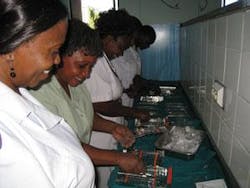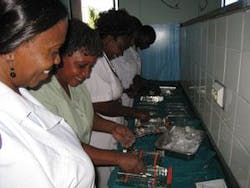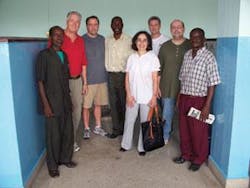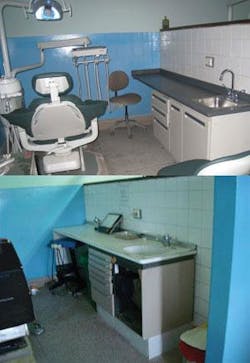The art of enlightened self-interest
By Eve Cuny, MS; Marion Bergman, MD, MPA; Alfred M. Hanssen, MSE
There are many ways in which dental manufacturers and distributors give back to the dental profession. Continuing professional education, support of oral heath care services in areas of need, products for oral health care missions, and donations to established charitable organizations are a few of the many ways the dental industry demonstrates social responsibility. These efforts enhance others’ lives while providing potential new markets or existing market support for the company.
When people think of the borders of their professional society, they consider them to include their country and often those of the closest geographical range or same continent. However, in today’s world of rapid transportation, instantaneous communication, and shared concerns regarding security, economy, and health care, we are truly a global society. What happens in other parts of the world often affects us here at home. An example in health care is the current spread of pandemic influenza. In this case, a disease that begins in one location has the potential to rapidly affect whole regions or the entire globe. We have all witnessed firsthand the interconnectedness of the world economies. When someone addresses the issues affecting a specific segment of society or region of the world, that person is also addressing issues that affect us all.
The arena of social responsibility provides an opportunity to develop partnerships with other like-minded businesses to increase the impact one can have on a societal problem. Just as in business, strategic alliances in philanthropy increase the likelihood of success. The story in this article shows how companies with different areas of expertise and technology came together to successfully take a special project from inception to completion.
Background
Following a roundtable discussion on investment and trade at the NASDAQ Stock Market®, organized by the U.S.-based nonprofit organization Miracle Corners of the World, Inc. (MCW) in May 2006, Tanzanian President Jakaya Mrisho Kikwete asked Stanley and Marion Bergman to look at the dental school at the Muhimbili University in Dar es Salaam, Tanzania. As the Chairman of the Board and Chief Executive Officer of Henry Schein, Inc., Mr. Bergman was keenly interested in expanding dental markets, and he has a reputation for promoting corporate social responsibility. Dr. Marion Bergman later confirmed that the school was indeed in dire need of new equipment. The government had paid to renovate the building, fix the leaking roof, and put in an additional floor, but there were no funds to upgrade the equipment, which was beyond repair.
The outcome of this invitation was that in September of 2008, Miracle Corners of the World (MCW) and Muhimbili University of Health and Allied Sciences (MUHAS) signed a Memorandum of Understanding (MOU) to collaborate on a project to improve oral health care across Tanzania. As part of the agreement, Tanzania’s only dental school, the MUHAS School of Dentistry, would receive new state-of-the-art equipment. The project moved on schedule, with the installation of the new equipment completed in the spring of 2009.
Dr. Marion Bergman, appointed by MCW Executive Director Eddie Bergman to jointly manage and execute the project with Dean Emil Kikwilu, considers industry stakeholders John Spencer and Dr. Anne Eiting Klamar key strategists. “This is an important part of building and upgrading Tanzania’s only school of dentistry, a school that already has an excellent reputation in public health education,” said Dean Kikwilu. All were guided by H.E. Ambassador Daudi Mwakawago, a former Permanent Representative of the United Republic of Tanzania to the United Nations, and an MCW advisor and board member instrumental in helping the U.S. team develop the dialogue on cooperation. One of the first people Dr. Bergman identified to assist in the planning and execution of the project was Dr. Dominick DePaola. As a dean and president of dental schools and research centers, Dr. DePaola brought knowledge and experience that was invaluable to planning the project. He served as chairperson of the international advisory committee for the project.
The MOU called for the Ministry of Health to clear the goods at customs. The university provided the necessary electrical upgrade and technical support staff, as well as two newly trained graduate technicians whom Midmark, Dental Components International (DCI), and Henry Schein, Inc. trained in maintaining and repairing dental units, handpieces, ultrasonic cleaners, autoclaves, and X-ray units. Operational training, maintenance, and equipment repair began in spring 2009 and is ongoing.
The essence of the undertaking was that each partner brought core competencies to the collaborative project. The vision was to address the inadequate access to oral health care in an underserved country. The rural areas where most Tanzanians live were especially hard hit by health care provider shortages.
“If we succeed in training students on a high-level, there will be a strong multiplier effect in terms of oral health,” said Professor Kisali Pallangyo, MUHAS Vice Chancellor and signatory to the MOU. He also noted that President Kikwete is “passionate about the dental school.” Valued at nearly $2 million in U.S. dollars, the donation of the equipment and technical expertise represents one of the largest donations to the school.
Muhimbili University School of Dentistry
Tanzania is an emerging nation of enormous natural resources, but it faces many challenges. It is the largest East African country and is situated on the Indian Ocean. Tanzania boasts Mount Kilimanjaro, the famous spice markets of Zanzibar, and the great endless plains of the Serengeti. However, in spite of the abundant natural resources and beauty, its people struggle against enormous obstacles, including limited access to health care, with only one doctor for every 200,000 people. As part of sub-Saharan Africa, Tanzania has been cruelly impacted by the AIDS pandemic the past 30 years, with an HIV disease rate of more than 8%. Malaria affects a large portion of the population, and the life expectancy for people in the country is only 47 years for men and 49 years for women. Most Tanzanians live in rural settings, far from established health-care services, making it difficult to access care and contributing to high maternal mortality rates and the low life expectancy.
Oral health care services are also inconsistently available in the country, in part due to the geographical challenges, but also due to the low number of properly trained dentists and dental therapists. There is only one dental school in Tanzania, and one or two others in all of East Africa. When the team was asked to assist the dental school at Muhimbili University in Dar es Salaam, the school had fallen into a state of disrepair that would threaten its continued existence.
Initiating the project
In the summer of 2007, John Spencer, CEO of DCI, and his daughter, Amy Spencer, visited the school with Dr. Bergman for a meeting with Dean Kikwilu. They performed a needs assessment. The Spencer family committed to an ambitious project — a total upgrade of the dental school. John Spencer insisted on using all new dental units that were easy to repair and find spare parts for. Dr. Bergman determined that infection control should be the cornerstone of the project. This was made possible by Dr. Anne Eiting Klamar, CEO of Midmark, a long-time supporter of MCW. It only took one visit by Dr. Eiting Klamar to convince her of the worthiness of the project. Midmark generously donated cabinetry and sterilization equipment and their top technical experts, who designed and installed the sterilization centers with the consultative input of Professor Eve Cuny of the University of the Pacific Arthur A. Dugoni School of Dentistry. Prof. Cuny also visited the school before and after the installation to provide assistance and training.
Of high importance to the project was the sustainability of the dental school after re-equipping the facilities. Installing new equipment and providing enough materials to treat patients for approximately one year would not meet the project goal, which was to create an environment to support the education and training of dental professionals in the region far into the future. An important outcome would be to increase access to oral health care services by increasing capacity at the school, and increasing the number of qualified trained professionals graduating and providing services throughout the country.
The dental school would need a revenue stream sufficient enough to support the ongoing purchase of materials and replacement of equipment. They would also need technical expertise locally, since services from dental manufacturers are scarce in the region. The coordination of these efforts to ensure sustainability eventually included individuals and groups from inside the university, the Ministry of Health and Social Welfare, corporate donors, and non-governmental organizations (NGOs). The dental school needed a plan it was invested in, not a plan that would be forced upon them by the project principles. Involving Dean Kikwilu and Ambassador Mwakawago paved the way for support of the project by the senior administrators of MUHAS and the Ministry of Health and Social Welfare. The dental school in Tanzania shares many of the same challenges as schools in the U.S. These include an aging faculty, low reimbursement rates, increasing costs of goods and services, and a patient population drawn from the underserved individuals in the community.
Environmental assessment
Any project in a developing region should include an environmental assessment. There is no “one size fits all” solution to the challenges of providing dental education or dental care in resource-restricted locations. In a situation such as this one, it was important to assess the availability of resources such as power, clean water and water pressure, ventilation, technical support personnel, and the current knowledge level of the faculty and other personnel who will benefit from the project. It was also important to assess the type of dental services that the school provides to its patients. It was important to involve the administration and faculty of the dental school to ensure the evaluation was an accurate understanding of the needs of the country.
After determining the needs of the dental clinics, it was then necessary to ensure that the equipment was appropriate for the setting. For instance, a vendor offered to provide digital radiographic equipment, but computers to view electronic images are not readily available to practitioners in the school and would certainly not be practical for use by most of the students upon graduation. Therefore, it was much more relevant to provide traditional X-ray units using standard dental X-ray film. Steam autoclaves were made available, but it is cumbersome for the dental school to obtain distilled water. Without distilled water, the sterilizers would likely quit working in a short time. The vendor solved the problem by also providing distillers.
Cultural context
It is important to know the ways that cultural context will affect a project, and that’s why working with existing organizations in a new region is useful for understanding the needs of the local population and making important contacts. In this case, Henry Schein Inc., in partnership with dental manufacturers, collaborated with MCW to bring important dental services to a country where MCW had already done considerable work. This is more effective than entering an arena where the company has no connections. Other companies wishing to expand their social responsibility programs could look to distributors, nonprofit health care organizations, and other nongovernmental interests to determine which will provide opportunities for effective partnerships.
More about Miracle Corners of the World and the Muhimbili University of Health and Allied Sciences
Established in Tanzania in 2001, MCW’s oral health care program addresses the oral health care needs of communities through dental outreaches, model dental clinic development, and dental school enhancement. In 2005, MCW built and equipped the Kipera Dental Clinic at the MCW community center site in rural Songea, Tanzania. As a result of an earlier MOU with the Songea Municipal Council, a government-employed dental therapist was assigned to the Kipera Dental Clinic to provide year-round service to the community.
“MCW not only launches new initiatives based on local needs assessments, but it also aims to strengthen existing institutions, particularly in areas where technical expertise is required, like the MUHAS dental school,” said MCW cofounder and executive director Edward Bergman. “In both cases, it’s always been important to us to make sure that our projects are sustainable beyond our start-up support.”
About Miracle Corners of the World
Founded in 1999, Miracle Corners of the World is a nonprofit organization that empowers youth to become positive agents of change to improve their lives and contribute to their communities. Based in New York, MCW serves youth worldwide through its three programs — Youth Leadership, Oral Healthcare, and Partner Initiatives. To achieve its mission, MCW works closely with a global network of friends, volunteers, and supporters from the public, private, and nonprofit sectors. For more information, visit www.miraclecorners.org.
Editor’s Note: References available upon request.
More Proofs Current Issue Articles
More Proofs Archives Issue Articles



